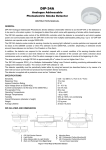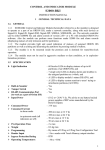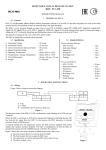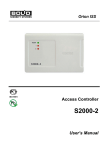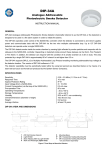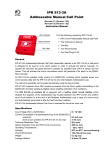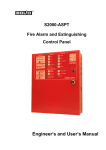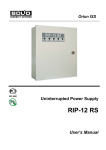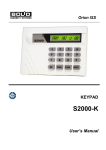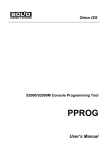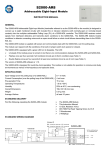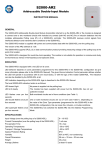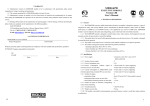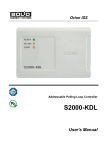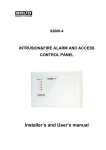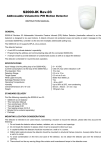Download S2000-PT User`s Manual
Transcript
Orion ISS Extinguishing Control and Indicator Module S2000-PT User’s Manual This User’s Manual is intended to help for studying operability principles and maintenance of the S2000-PT Extinguishing Control and Indicator Module of version 1.01. Please read the instructions completely before connecting, operating, adjusting, or maintaining this product. The following terms are used throughout the Manual: Alarm Loop (or Loop, or LP): The electrical circuit with non-addressable fire or intrusion detectors (or other non-addressable devices) included. Actuation of a single detector brought in an alarm loop causes breaking of the loop as a whole, so the actuated detector can be located only with the accuracy of the alarm loop Zone: A minimal part of a security and safety installation that can be monitored and controlled independently. Depending on the context, the term ‘zone’ can imply an alarm loop, an addressable detector, a hardwire component, etc. Partition: A set of zones that can be user controlled as a whole. As a rule, zones fall into partitions depending on their location (e.g., one partition can involve all zones at one individual area) Network Address: A unique number of the module (1 to 127) within the local RS-485 network of the Orion integrated security system Network Controller: A hardware/software which monitors for and controls the devices of the Orion integrated security system. It can be an S2000(M) console or a PC with installed Orion Pro software S2000-PT Table of Contents General ............................................................................................................................................... 5 Specifications .................................................................................................................................... 9 Operation Principles ........................................................................................................................ 13 Indication .................................................................................................................................. 14 Light Indication of Module Statuses 14 Light Indication of Partition Statuses 14 FIRE LED TROUBLE LED LOCKED LED AUTO LED EXTINGUISHING LED 14 15 15 15 16 Light Indication of Alarms and Troubles in Partitions 16 Sound Indication of Partition Statuses and User Requests 17 Light Indication of the Reader 17 Agent Release Control .............................................................................................................. 18 Events and Commands Transferred to the Network Controller ................................................. 21 Installation ........................................................................................................................................ 23 Standard Delivery ..................................................................................................................... 24 Safety Precautions .................................................................................................................... 24 S2000-PT Mounting .................................................................................................................. 24 Wiring the RS-485 Interface Line .............................................................................................. 25 Connecting a Power Supply ...................................................................................................... 26 Getting Started.......................................................................................................................... 26 Programming ................................................................................................................................... 27 Module Settings ........................................................................................................................ 30 Network Controller Settings ...................................................................................................... 33 Adding the S2000-PT to the Configuration of the Network Controller 33 Creating Partitions 35 Adjusting the Network Controller for Receiving Control Commands 36 Maintenance ..................................................................................................................................... 41 Inspecting Module’s Operation Conditions ................................................................................ 43 Testing the S2000-PT in Self-Diagnostic Mode ......................................................................... 43 Checking for Communication Conditions over the RS-485 Interface ......................................... 44 3 www.bolid.com Orion ISS Testing the iButton Reader and Its LED ................................................................................... 44 Troubleshooting........................................................................................................................ 45 www.bolid.com 4 S2000-PT General GENERAL 5 www.bolid.com Orion ISS The S2000-PT Extinguishing Control and Indicator Module (hereinafter referred to as the module) is designed to operate within Orion Integrated Security Systems as a device for remote managing a number (up to ten) of S2000-ASPT devices, each assigned with a specific partition of the Orion system and managing a specific agent releasing application. The module provides: Light indication of statuses of related partitions (related S2000-ASPT), Light and (optionally) sound indication of various alarms and troubles in related partitions, Remote releasing extinguishing agent and remote cancellation of releasing extinguishing agent for related applications, Enabling and disabling the automatic mode of releasing extinguishing agent for related applications. Remote control of fire extinguishing processes by the S2000-PT is performed through the network controller. The network controller can be either an S2000M fire and alarm console of versions 2.03+ or a PC with Orion Pro software installed. The S2000-PT receives an information about statuses of related partitions (related S2000-ASPT) from the network controller over the RS-485 interface representing this information by means of light and sound indication. In addition, if programmed, the S2000-PT transfers the network controller user commands to turn on / off automatic mode of releasing extinguishing agent and to start / cancel starting releasing. The network controller, upon receiving such a command, analyses the received data, makes a decision about gaining access to the requested operation, and, if access is granted, retranslates the executive command to the relevant S2000-ASPT. To establish authorized remote control of releasing extinguishing agent, a reader of iButtons (Touch Memory access devices) can be connected to the S2000-PT. In such case controlling system partitions through the S2000-PT is available for users within 30 seconds after touching their iButtons to the reader, these iButtons being pre-registered by the network controller with specific rights to control specific partitions. The S2000-PT has a built-in sounder which is used to indicate alarms and troubles in the system partitions assigned to this S2000-PT. Sounds can be silenced either manually, by pressing the SILENCE button, or automatically, upon elapsing the programmed operation time. The module can be powered by a power supply providing 12 V or 24 V dc. It is advised to use Bolid manufactured battery backed power supplies of series RIP-12 or RIP-24. The module is equipped with a tamper switch. On changing tamper switch’s statuses the module sends the network controller relevant messages about tampering / restoring its enclosure. www.bolid.com 6 S2000-PT General All the messages about S2000-PT events such as power failures, enclosure tampering / restoring, turning on / off the automatic mode of releasing extinguishing agent, starting / canceling starting agent releasing applications as well as resetting sound alarms by an operator are sent to the network controller. In case of a loss of communication over the RS-485 interface such messages are collected in the non-volatile memory of the S2000-PT (up to 16 messages) and, on restoring communications, they are transferred to the network controller with the time and date of origin specified by the internal S2000-PT clock. The module is to be programmed using the tool of configuring all the devices of the Orion system, the UProg.exe (of version 4.0.0.825 and above). All settings of the S2000-PT are stored in the module’s non-volatile memory. The last version of the UProg.exe can be downloaded from the site of the Bolid Company at the address of www.bolid.com in Software section. The module is connected to the PC where the UProg.exe is installed via the S2000M console switched to the Interface Converter or Programming mode as well as via one of the Bolid manufactured interface converters PI-GR, S2000-PI, S2000USB, USB-RS485. The S2000-PT module is attached within premises near an operator’s work place at locations protected against atmospheric fallouts and mechanical damage and is designed for round-the-clock operation. The module is not suitable for operation in corrosive or dusty environments as well as firehazardous areas. The S2000-PT module (see Figure 1) has ten indicator strings «1» to «10» (1) designed to indicate statuses of up to ten agent releasing applications related with the module. Each indicator string of 5 two-color LEDs can display such events or statuses in the related partitions as fire detector’s responding, S2000-ASPT troubles, and locking start of the related agent releasing application as well as display the current mode of releasing (automatic or manual) and the current status of the extinguishing system operating. So, each indicator string of the module is intended to display statuses of a single S2000-ASPT device. In addition, each indicator string contains two control buttons (2) pushing which switches on / off the automatic mode of starting fire extinguishing application as well as remotely starts / cancel starting the application. Seven single-color LEDs (4) at the right are designed to indicate alarms and troubles retranslated by the network controller from the S2000-ASPT related to the module. READY LED (3) indicates conditions of the S2000-PT itself. The module has a built-in sounder which indicates receiving alarms from partition related to the S2000-PT. The SILENCE button (5) is designed to reset sounding manually. 7 www.bolid.com Orion ISS 3 2 4 1 5 Figure 1 www.bolid.com 8 S2000-PT Specifications SPECIFICATIONS 9 www.bolid.com Orion ISS 21 Control Buttons Number of Partitions 10 Alarm and Trouble Indicators 10 strings of five LEDs each to indicate statuses of 10 related partitions, 7 LEDs to indicate alarms and troubles in all related partitions, READY LED to indicate statuses of the S2000-PT itself Internal Sounder Built-in Tamper Switch Built-in Event Log Capacity 16 events RS-485 Communication Port Yes Transmission Rate 9600 Bd Data Transmission Half-duplex Power Supply External 12 V to 24 V dc Bolid manufactured RIP-12 or RIP-24 battery backed power supplies are advisable Input Voltage 10.2 ÷ 28.4 V dc Input Power 3 W max Consumed Current Alarm Mode 250 mА max @ 12 V, 130 mА max @ 24 V, Quiescent Mode 30 mА max @ 12 V, (all LEDs are on) 20 mА max @ 24 V, Pre-Operation Time 2 s max External Reader One Reader Input to connect an external iButton reader Output Interface Touch Memory (1-Wire, µ-LAN) Reader LED One LED controlled by logical +5 V CMOS levels with current values being restricted by 10 mA at direct connection Operating Temperatures www.bolid.com −30 °С to +50 °С 10 S2000-PT Specifications Ingress Protection Rating IР20 Overall Dimensions 170 mm х 340 mm х 25.5 mm Weight 0.6 kg Average Lifetime 10 years Device Programming By means of the UProg.exe, the tool for configuring devices of an Orion system Connection to a PC Over the RS-485 interface bus via one of the Bolid manufactured interface converters PI-GR, S2000-PI, S2000-USB, USB-RS485 11 www.bolid.com Orion ISS www.bolid.com 12 S2000-PT Operation Principles OPERATION PRINCIPLES 13 www.bolid.com Orion ISS INDICATION The S2000-PT module is equipped with 50 LEDs (indicator strings “1” to “10”) to indicate statuses of ten related partitions, the READY LED to indicate statuses of the module itself, and 7 LEDs to represent alarms and troubles of various types which are happening in the part of the system related to the S2000-PT at the time. In addition, the S2000-PT is equipped with a sounder and can issue various audible signals for various events. The partitions which statuses are indicated by the S2000-PT should be formed by a System Administrator (the descriptors of the partitions should be added to the network controller configuration), and the numbers of these partitions should be linked to the relevant indicator strings “1” to “10” in the S2000-PT configuration (see Section Module Settings). If a reader is connected to the module then the reader LED indicates user-to-system interaction on user’s requesting access to control releasing extinguishing agent by S2000-PT buttons. Light Indication of Module Statuses Operating conditions of the module S2000-PT are indicated by the green LED “READY” as follows: Norm (quiescent mode) On No communication over the RS-485 interface Flashes twice per second Programming Flashes four times per second In case of loss of the communications over the RS-485 interface within 15 to 30 seconds, READY starts flashing twice per second (provided that the input power is in norm). The LED stop flashing and returns to steady lighting after restoring communications. Light Indication of Partition Statuses Statuses of the ten Orion system partitions assigned with the module are indicated by relevant indicator strings each containing five LEDs namely FIRE, TROUBLE, LOCKED, AUTO, and EXTINGUISHING. FIRE LED A FIRE LED indicates receiving responses of fire detectors connected to alarm loops of the related S2000-ASPT as well as statuses of the S2000-ASPT’s zones of manual and remote releasing of extinguishing agent. www.bolid.com 14 S2000-PT Operation Principles If any zone of the related partition (either a zone of alarm loops with connected fire detectors or one of the zones of manual and remote releasing) has entered the Fire Alarm status then the partition is also assigned to the Fire Alarm status. If there is no zone in the Fire Alarm status but at least one zone has entered the Fire Prealarm status then the partition is assigned to the Fire Prealarm status. If the partition has just entered the Fire Alarm status and at another zones a Fire Prealarm message is received then FIRE LED behavior will not change. On module’s receiving from the network controller messages about resetting alarms on the S2000ASPT related to the partition, the FIRE LED is turned off. The behavior of FIRE LEDs from the highest to the lowest priorities of partition statuses is as follows: FIRE ALARM Flashes in red twice per second FIRE PREALARM Flashes in red once per two seconds Norm Off TROUBLE LED The TROUBLE LED indicates such troubles and faults occurred during operating the related S2000ASPT as alarm loop troubles, troubles of S2000-ASPT executive outputs, power troubles, enclosure tampering, and loss of communication between the S2000-ASPT and the network controller. The partition is considered to be in the Trouble status is there is one of the troubles listed above in this one. TROUBLE Flashes in red once per two seconds Norm Off LOCKED LED The LOCKED LED is turned on when releasing extinguishing agent for the related application cannot be started (for example, the door to the protected premises is open during counting the Pre-discharge Delay). Release is locked Lit steady in red Norm Off AUTO LED The AUTO LED shows which mode is currently set for releasing extinguishing agent at the application related with the partition: automatic (on responding fire detectors connected to the S2000-ASPT) or manual (on receiving a manual alarm from the manual call point connected to the S2000-ASPT or a remote release command from the network controller). 15 www.bolid.com Orion ISS The AUTO button has Flashes in green and red alternately twice per second until the just been pushed relevant command is executed or rejected (see Section Agent Release Control) The automatic mode of Lit steady in green releasing agent is turned on The automatic mode of Off releasing agent is turned off EXTINGUISHING LED Each EXTINGUISHING LED indicates various steps of operating of the agent releasing application related to this indicator string. EXTINGUISHING button has Flashes in green and red alternately twice per second until the just been pushed relevant command is executed or rejected (see Section Agent Release Control) Pre-discharge Delay Flashes in red once per two seconds Release Flashes in red twice per second Release Fault Flashes in yellow once per second Agent is being released Lit steady in red Releasing cancelled Off Quiescent Mode Off Light Indication of Alarms and Troubles in Partitions Summarized statuses of all the partition assigned to the module are showed by alarm indicators FIRE and PREALARM as well as by trouble indicators LOOP, OUTPUT, POWER, COMMUNICATION, and TAMPERING at the right part of the S2000-PT. The summarizing indicator FIRE indicates presence of a fire in one or more partitions related to the module by flashing in red once per second. The summarizing indicator PREALARM is turned on (flashes in red once per two seconds) if one or more of the partitions related to the module have entered the Prealarm status. Indicator of TROUBLE group at the right part of the module flashes in yellow once per two seconds if there is a relevant trouble in one or more partitions: LOOP Trouble of the alarm loop of an S2000-ASPT OUTPUT Trouble of the relay output of an S2000-ASPT www.bolid.com 16 S2000-PT Operation Principles POWER Main power failed or power trouble of an S2000-ASPT COMMUNICATION No communication with an S2000-ASPT over the RS-485 bus TAMPERING The enclosure of an S2000-ASPT is open Sound Indication of Partition Statuses and User Requests The sounder of the S2000-PT operates as follows: Fire Alarm Issues long beeps each two seconds Fire Prealarm Issues two beeps once per two seconds Trouble Issues a beep once per four seconds User Request (an iButton is touched to Issues a beep the reader) Illegal Code (the iButton has no rights Issues a long sound (about 1 s) for requested operation) Access Granted Issues two beeps If several partitions related to the S2000-PT have various statuses which should be indicated,the sounder indicates the status with the highest priority. Fire Alarm is the status of the highest priority, the Fire Prealarm is the status of lower propriety, and the Trouble status is of the lowest priority. Sounds can be silenced by pushing the SILENCE button. When the SILENCE button is pressed the module sends the S2000М or the computer the Alarm Cancelled message. Sound signaling also can be stopped automatically after elapsing a time programmed for the module (see Section Module Settings). No messages about automatic silencing are sent to the network controller. Light Indication of the Reader If a reader is connected to the module, the LED of the reader indicates the following events: A user has touched his or her iButton to the The reader LED flashes twice per second reader (User Request) The iButton toched to the reader has no rights The reader LED is off for requested operation (Illegal Code) The requested operation is allowed (Access The reader LED lights within 30 s Granted) 17 www.bolid.com Orion ISS AGENT RELEASE CONTROL The S2000-PT has two control buttons for each of the ten related partitions. The AUTO button switches the current mode of releasing extinguishing agent from automatic to manual and back. The EXTINGUISHING button allows remote releasing or cancelling release of extinguishing agent. For authorized control by AUTO and EXTINGUISHING buttons, a user shall touch his iButton (key) to a reader connected to the S2000-PT. The key shall be enrolled by the network controller. Also the key shall be assigned to a number of partitions which are enabled for this key to control as well as to specific rights to control the partitions (see Section Adjusting the Network Controller for Receiving Control Commands). These partitions, in turns, shall be assigned to the indicator strings of the S2000PT (see Section Module Settings). The S2000-PT can also be assigned to a built-in password (an access code) which enables controlling partitions without user authorization by Touch Memory devices. This alternative can be used when the module is located at a place protected against unauthorized access. The password (or PIN code, or access code) is programmed in the configuration of the S2000-PT using the UProg.exe (see Section Module Settings). This password shall also be enrolled in the configuration of the network controller with relevant rights to control relevant partitions (see Section Adjusting the Network Controller for Receiving Control Commands). In case of user’s touching his iButton to the S2000-PT reader, the module sends the code of the iButton to the network controller over the RS-485 interface. The network controller verifies the received code, the module sounder being activated for 0.25 s and the module LED flashing 2 times per second. If the presented iButton is enrolled in the network controller configuration, then the Access Granted signal sounds and the module LED is lit steady for 30 seconds. After that the user can control partitions by using AUTO and EXTINGUISHING buttons within 30 seconds. On user’s pressing a button the module sends the network controller the request for executing the relevant control command (turning on / off the automatic mode of releasing extinguishing agent or remote release / cancel releasing extinguishing agent). The network controller considers the received request and makes an access decision. If the electronic key has all the required access rights, the network controller transfer the control command to the relevant S2000-ASPT (see below) and then returns the module the result of the operation via the RS-485 interface. If the iButton is not registered by the network controller, then touching it to the module reader causes issuing the Illegal Code sound and the module LED is turned off. www.bolid.com 18 S2000-PT Operation Principles If presenting electronic keys is not needed for controlling partitions, then on pressing one of the buttons AUTO or EXTINGUISHING the S2000-PT sends the network controller over the RS-485 the relevant request and its build-in password (access code). The network controller considers the received request and makes an access decision. If the module access code is enrolled in the configuration of the network controller (see Section Adjusting the Network Controller for Receiving Control Commands) and have rights for the requested operation, then the network controller sends the relevant executive command to the S2000-ASPT related to the pressed button (see below) and then returns the S2000-PT the result of operation over the RS-485 interface. If, otherwise, the access code of the S2000-PT is not written in the configuration of the network controller, the Illegal Code signal sounds. If the module password is enrolled in the network controller configuration but have no rights to control releasing extinguishing agent, then user’s pressing on an AUTO or EXTINGUISHING button causes the LED adjacent to the button to flash until the requested command is rejected (see Section In case of loss of the communications over the RS-485 interface within 15 to 30 seconds, READY starts flashing twice per second (provided that the input power is in norm). The LED stop flashing and returns to steady lighting after restoring communications. Light Indication of Partition Statuses). In such cases when permission to control an S2000-ASPT device from the S2000-PT is granted, the AUTO and EXTINGUISHING buttons operates as follows: To activate the automatic mode Push the AUTO button if the relevant LED is turned off of releasing extinguishing agent To disable the automatic mode of Push the AUTO button if the relevant LED is turned on releasing extinguishing agent (the manual mode only) To release extinguishing agent Push the EXTINGUISHING button for more than 3 s To cancel releasing Push the EXTINGUISHING button shortly, within 0.2 s to 1 s Pushing an AUTO button of the S2000-PT entails giving the relevant S2000-ASPT a command for changing the current mode of starting the connected fixed extinguishing system. If the automatic mode (starting on receiving responses from fire detectors) is in force, this mode will be switched to the manual mode (starting on pressing a manual call point or receiving the relevant command from the network controller), and vice versa. Pushing an EXTINGUISHING button of the S2000-PT entails giving the relevant S2000-ASPT a command to start releasing extinguishing agent or to abort releasing, depending on its current status. 19 www.bolid.com Orion ISS If the agent releasing application has just been started, then on short-time pushing the EXTINGUISHING button the application will be stopped. Otherwise, if the agent releasing application is not started, on pushing the EXTINGUISHING button for more than 3 s the related S2000-ASPT enters the modes Fire Alarm and Pre-discharge Delay when the S2000-ASPT begins counting the programmed pre-discharge delay and the EXIT light table is turned on. Upon the expiration of the pre-discharge delay the S2000-ASPT enters the Release mode. In this mode the S2000-ASPT generates a starting pulse and gives a command to activate connected modules S2000-KPB. The EXIT table is turned off while the KEEP OUT table is turned on. Upon the expiration of the starting pulse the S2000-ASPT enters the Extinguishing mode if pressure sensors in the extinguishing agent control circuit have responded. www.bolid.com 20 S2000-PT Operation Principles EVENTS AND COMMANDS TRANSFERRED TO THE NETWORK CONTROLLER The S2000-PT automatically sends the network controller over the RS-485 interface the following messages about its states: TAMPER ALARM The module enclosure is open TAMPER RESTORED The module enclosure is closed ALARM RESET The SILENCE button is pressed on receiving an alarm DEVICE RESTART The watchdog timer is reset The S2000-PT provides buffering events sent to the network controller over the RS-485 interface. If a communication loss occurred during generating a message lasts more than one minute then the relevant event is stored in the non-volatile memory of the S2000-PT. When the communication is restored, the event will be transmitted via the RS-485 interface to the network controller with the time and date assigned in accordance with the internal clock of the module. The network controller synchronizes the internal clock of the S2000-PT to its own clock by automatic sending a Synchronize Clock command transferred via the RS-485 interface (commonly, at the beginning of each hour). The S2000-PT sends the network controller over the RS-485 bus the following commands: SET AUTO MODE Pushing an AUTO button when the related AUTO LED is off SET MANUAL MODE Pushing an AUTO button when the related AUTO LED is on RELEASE» Pushing an EXTINGUISHING button for more than 3 s CANCEL RELEASING Quick pushing an EXTINGUISHING button The commands said above are sent only after user’s granting access to control partitions (see Section Agent Release Control) 21 www.bolid.com Orion ISS www.bolid.com 22 S2000-PT Installation INSTALLATION 23 www.bolid.com Orion ISS STANDARD DELIVERY Find the following unpacking the S2000-PT: The S2000-PT Control and Indicator Module The data sheet CD disk with this User’s Manual Four woodscrews 1- 4х40.016 with wall plugs Note: Access devices DS1990A and a reader such as Schityvatel-3 or similar should be ordered and supplied separately. SAFETY PRECAUTIONS There are no potential hazard circuits within the module Do SHUT OFF the power from the module before mounting, wiring, or maintaining the S2000-PT Mounting and maintenance the S2000-PT must be performed by qualified engineers S2000-PT MOUNTING Figure 2 display the appearance of the module as well as its overall and mounting dimensions. The S2000-PT is to be attached to walls or any other structures near the operator’s location in premises protected against atmospheric fallouts and mechanical damage. Mount the module and its connecting lines in accordance with the Wiring Diagram (see Figure 3). Attach the module at the height of 1.5 meters above the floor. www.bolid.com 24 S2000-PT Installation Figure 2. Overall and Mounting Dimensions of the S2000-PT WIRING THE RS-485 INTERFACE LINE Connect RS-485 interface lines as shown in the electric wiring diagram below (see Figure 3). S2000-PT RS-485B 1 RS-485A 2 0V 3 0V +U 4 (12…24) V Ind 5 0V 6 ТМ 7 To an S2000М console or PC To a power supply Touch Memory reader Figure 3. Wiring Diagram for S2000-PT Operating 25 www.bolid.com Orion ISS To connect the module to the network controller via the RS-485 interface bus, attach its RS-485A and RS-485B terminals to the A and В lines of RS-485 bus respectively. Wires are connected to the S2000-PT by means of its screw terminal block. The maximum wire cross-section area is 1.5 square millimeters. If the module is neither the first nor the last device within the RS-485 bus, remove the jumper set on the module PCB near the RS-485A and RS-485B terminals. WARNING! If the RS-485 interface bus is quite long (more than 1000 meters), use twisted-pair cabling to connect the devices. The resistance value of each RS-485 interface line (A or B) measured between the network controller and the most distant device MUST NOT exceed 200Ω. While wiring the RS-485 interface bus, you are advised to configure the device network as “the bus” (that is, connect devices in a chain). If a long-distance branch (more than 50 meters from the RS-485 bus) needs to be made, an S2000-PI interface repeater (produced by the Bolid Company) is to be included at the cross point. The number of successively included repeaters is not restricted. CONNECTING A POWER SUPPLY Connect a power supply of 10 V to 28 V to the 3 and 4 terminals of the module (see Figure 3). We recommend you to use Bolid manufactured power supplies of RIP series. Couple the 0 V circuits of the S2000-PT and the network controller. If both the devices are connected to a single power supplies, their 0 V circuits need not be coupled. GETTING STARTED After mounting the S2000-PT and its connecting lines turn the module’s power supply on. The READY LED of the module shall light in green. The S2000-PT to work as a part of an Orion system under control of a network controller, it must be assigned to a unique network address (see Section Module Settings). www.bolid.com 26 S2000-PT Programming PROGRAMMING 27 www.bolid.com Orion ISS To program the S2000-PT module for operating your specific functions, give or change settings of the configuration parameters stored in its non-volatile memory by doing the following. Connect the module to a computer via one of the Bolid manufactured interface converters (such as PI-GR, S2000-PI, S2000-USB, or USB-RS485) or through the S2000М console (which should be switched to the programmed mode as described in its Manual). The tool for configuring the devices of the Orion system, UPpog.exe, of versions 4.0.0.825 and above must be run on this computer. After running the UProg its working window is opened on the PC display. At the top part of the window there are the Main Menu and the Toolbar. Select the Device → Read Device Configuration command (or press <Ctrl+F3>, or select the icon from the toolbar). Figure 4 The window for searching devices will be output on the display. Specify the number of the logic COM port the S2000-PT is connected to, and the UProg will start searching the devices connected to this COM port of the PC (see Figure 4). As a result of this searching, list of all found devices with their network addresses and version numbers will be shown at the display (see Figure 5). Figure 5 www.bolid.com 28 S2000-PT Programming Select the entry for the S2000-PT by left mouse clicking, and then click the Select button. The UProg will display the window with current settings of the S2000-PT (see Figure 6). After opening the window with settings, the S2000-PT module enters the programming mode, with its READY LED flashing 4 times per second. Figure 6. The Work Window of the UProg for Configuring the S2000-PT You can also get an access to the module settings by loading the S2000-PT configuration from the relevant file with .cnu extension written to any data storage, using the File →Load Configuration File command (or the <F3> button, or the toolbar icon). Besides, a new configuration file can be created by using the File → New Configuration menu command (or the <Ctrl+N> button, or the toolbar icon). The command File → Base Configuration is intended for loading factory setting values to the empty configuration created in the UProg. 29 www.bolid.com Orion ISS The newly created or revised configuration can be: Loaded to the module memory , or Device → Write Configuration to This Device Loaded to the memory of another Device → Write Configuration to Another Device connected S2000-PT with specified network address Saved to a file of the internal UProg , or <F2>, or File → Save Configuration to File format with the .cnu extension Written as a text to an MS Word file , or File → Export Configuration to MS Word MODULE SETTINGS The configuration parameters shown in Table 1 define the general operating features of the S2000-PT as well as its network parameters for operating as a part of an Orion ISS system. Table 1. Configuration Parameters of the S2000-PT Module Parameter Description Range Factory Value Network Address A unique number of the module in the RS485 interface bus 1 to 127 127 Partition Number A number of that partition in the network controller configuration which is linked with each string of status indicators of the module 0 to 9999 1 to 10 Sound Duration The time after elapsing which the module sounder is automatically turned off 0 s to 255 s 0s Access Code A four-digit password with which the S2000-PT is registered in the network controller database as a user having some rights to control fire extinguishing 0000 to 9999 Empty The Network Address parameter is intended to identify uniquely the module in the Orion device system. The module sends messages and receives commands from the network controller only using the address specified by this parameter. The network address must be unique for each Orion system device. To program or change the network address of the module, select the command Device→ Change Device Address in the menu of the UProg and enter the proper number in the range of 1 to 127 in the appeared dialog box (see Figure 7). www.bolid.com 30 S2000-PT Programming The network address of the S2000-PT can also be programmed or changed by means of the network controller as described in its Manual. Figure 7 In order the indicator strings 1 to 10 displays statuses of actual partitions of the Orion system programmed in the network controller database, these indicator strings should be linked to the partitions by the set of Partition Number parameters. To set or change a Partition Number, left clock the field of the programmed indicator string and enter the partition number into the relevant dialog box in the upper part of the UProg window (see Figure 6). For unused indicator strings set the partition Number to zero. 31 www.bolid.com Orion ISS The Sound Duration parameter defines the time of module sounder’s being turned on when an alarm is received. To set or change the Sound Duration, enter a proper value ranged from 0 to 255 to the relevant dialog box at the bottom of the UProg window (see Figure 6): 0 – if sound signaling of the module is to be disabled, 1-254 – the time in seconds since module’s receiving an alarm until the sounding is turned off automatically, 255 – to disable automatic silencing: sounder will be on until the SILENCE button is pressed. The Access Code parameter defines a built-in password (PIN code) of the module and allows user to get access to control partitions without access devices Touch Memory. The S2000-PT sends this password to the network controller over the RS-485 interface when the user pushes one of the AUTO or EXTINGUISHING buttons. The password (access code) should also be enrolled in the database of the network controller (see Section Adjusting the Network Controller for Receiving Control Commands). To set or change an Access Code, enter a four-digit code into the Access Code dialog box at the bottom of the UProg window (see Figure 6). Let the field empty or clear it if controlling partitions by the S2000-PT without presenting electronic keys is prohibited. www.bolid.com 32 S2000-PT Programming NETWORK CONTROLLER SETTINGS Adjust a network controller by means of the PProg.exe if it is an S2000М or by means of Database Administrator software if the Orion Pro software operates the system. To program the network controller to operate the S2000-PT, do the following: Enroll the S2000-PT to the network controller database; Create the relevant partitions; Enroll all the relevant users with their authenticators (PIN codes or access devices) to the network controller database and assign the users to the rights to control the created partitions; Enable the S2000-PT to control these partitions. This Manual describes the procedures of programming an S2000М console by means of the PProg.exe. Before working with this program the console should be switched to the programming mode as described in its manual. If Orion Pro software is used as the network controller, program the software as described in the Orion Pro’s documentation. The last version of the PProg.exe can be downloaded from the site of the Bolid Company at the address of www.bolid.com. Adding the S2000-PT to the Configuration of the Network Controller 1. Run the PProg.exe selecting a number of the COM port which the S2000M console is connected to in the Search window on the Devices tab and clicking the Start Searching button . On finishing the procedure of searching a list of all connected devices will be appeared. Each device in the list is shown with its address, type, and version number (see Figure 8). After program’s finding the console its configuration can be written or read. Read the console configuration by the menu command S2000 → Read Configuration. You can also create a new configuration by the menu command File → New. 2. Add the S2000-PT to the tree of the devices by dragging and dropping it from the Search window to the Devices window with left mouse button (see Figure 9). The Inspector (Device) window is designed for displaying, entering, and editing the parameters of a selected device. 33 www.bolid.com Orion ISS Figure 8 Figure 9 You can add the S2000-PT to the S2000М configuration and set its parameters manually if the module is not connected to the console. For doing so, click on the Add button , enter the network address of the module in the Inspector (Device) window, select its type (S2000-PT) from the dropdown list, and specify the version number (1.01). www.bolid.com 34 S2000-PT Programming Creating Partitions 1. Go to the Partitions (Zones) page of the PProg using the button 2. Create a new partition by clicking the button . (see Figure 10). Figure 10 3. In the Partitions (Zones) window select the proper S2000-ASPT which will be assigned to the created partition, and drag and drop its descriptor to the upper window, on the partition descriptor (see Figure 11). All zones of the selected S2000-ASPT will be added to the partition. 35 www.bolid.com Orion ISS Figure 11 Adjusting the Network Controller for Receiving Control Commands To adjust the S2000-PT to send control commands, you must define the user rights to control the fire extinguishing system as well as module’s rights to control specified partitions in the configuration of the network controller. User rights are defined via assigning a user to an Access Group. Each Access Group is a set of user rights which consists of a list of partitions enabled for controlling and actions permitted for each partition. For an S2000-PT a user can be allowed to perform such actions as turning on and off the mode of automatic releasing extinguishing agent as well as remote starting / cancelling the start of the fixed fire extinguishing installation. 1. To create an Access Group, go to the Access Group page of the PProg clicking the button 2. Create a new Access Group by clicking on . . In the Inspector (Access Group) window select the proper number and type the name or a short comment (optionally) of the Access Group (see Figure 12). www.bolid.com 36 S2000-PT Programming Figure 12 3. In the Partitions window select the partitions which are enabled to be controlled for this Access Group. Move them up, on the created access group descriptor by left mouse button (see Figure 13). Figure 13 37 www.bolid.com Orion ISS 4. In the Access Groups window select the partition and give the rights to control this partition in the Inspector (Rights) window. Then you should assign the programmed Access Group with the PIN-code (the Access Code) of the S2000-PT or with user authenticators, entering / presenting which will be considered by the network controller as an authorized command to get access to partition control. For doing so: 1. Go to the Authenticator page of the PProg clicking on 2. Create a new descriptor clicking the button . (see Figure 14). Figure 14 3. Enroll the first user iButton. For doing so click on the Read Key button and select the system reader the iButton will be touched to. Then touch the access device to the reader. The code of the device shall be shown in the Code field (see Figure 15). 4. Enter the user name and assign the authenticator to the proper Access Group in the Inspector (Authenticator) window. The type of the authenticator (Key) shall be defined by the program automatically. www.bolid.com 38 S2000-PT Programming Figure 15 5. Repeat steps 2 to 4 for all the user electronic keys which are to be enrolled. 6. If users are to be allowed to control partitions without presenting iButtons, register the built-in password of the S2000-PT. Add a new descriptor by clicking the button and enter the access code of the S2000-PT to the Code field of the Inspector (Authenticator) window. This code must be the same as the code programmed for the S2000-PN in its configuration (see Section Module Settings). Then enter the name (or comment) of this authenticator to the User field and assign the S2000-PT access code to the Access Group which, in turns, is assigned to partitions which will be controlled by users from the S2000-PT. The type of the authenticator (Password) will be defined by the program automatically. Rights of the module (to control partitions) are programmed by defining the list of the partitions allowed to be controlled by the S2000-PT in the network controller configuration. To program control rights of the S2000-PT: 1. Go to the Device Rights page of the PProg by clicking the button 2. In the Partitions window select the partitions which are allowed to be controlled by users operated . the S2000-PT (both with and without touching their Touch Memory devices). Move selected partitions to the Device Rights window on the S2000-PT descriptor by left mouse button (see Figure 16). 39 www.bolid.com Orion ISS Figure 16 Finally, the changed or newly created configuration of the console can be: Loaded to the console , S2000 → Write Configuration Saved in text format to a file with the , File → Save, File → Save As .txt extension or encrypted to a file of .gpc format www.bolid.com 40 S2000-PT Maintenance MAINTENANCE 41 www.bolid.com Orion ISS To make sure the S2000-PT keeps proper operability it shall be inspected by a competent specialist at least on receipt and annually. The inspection algorithm shall include: Visual checking the S2000-PT for contaminations and mechanical damage, Verifying the S2000-PT for secure mounting and wire connection conditions, Inspecting operability of the S2000-PT in accordance with the techniques discussed below. Inspection of the S2000-PT shall be performed by competent personnel of the Service Company. On completing the inspection the results shall be written into an S2000-PT maintenance log book. If during the warranty period the module does not meet any requirements set forth in this section, this will be the grounds to raise a climb to the manufacturer. The module should be inspected under the following ambient conditions: − Relative humidity: 45 % ÷ 80 %; − Ambient temperature: 25 °С ±10 °С; − Atmospheric pressure 630 ÷ 800 mm Hg. Power off the module before connecting and disconnecting wires. Take into account the pre-operation time of the module which shouldn’t exceed 2 s www.bolid.com 42 S2000-PT Maintenance INSPECTING MODULE’S OPERATION CONDITIONS 1. Wire the S2000-PT for inspection as shown in Figure 17, but not connecting the wires of the RS485 bus to the S2000М console. 2. Turn the module power on. 3. The READY LED of the S2000-PT shall be lit steady in green for a time and then flash once per second. 4. Measure the current consumed by the S2000-PT. The value of the current shall not exceed 300 mA. S2000М RS-485B 1 1 RS-485B RS-485A 2 2 RS-485A 0V 3 +U 4 +U 1 0 2 S2000-PT RIP-12 (RIP-24) А 3 +U 4 0 Figure 17. Wiring the S2000-PT for Functional Testing TESTING THE S2000-PT IN SELF-DIAGNOSTIC MODE To start self-diagnostic procedure, push SILENCE button three times shortly and then once more long1. If the module is operable its LEDs are turned on as follows: 1. Columns of indicators “1” to “10” are turned on one-by-one in red, and then one-by-one in green; 2. Strings of indicators “1” to “10” are turned on one-by-one in red, and then one-by-one in green; 3. All status indicators and single-color indicators are turned on together, status indicators being kit in red; 4. All status indicators and single-color indicators are turned on together, status indicators being kit in green; 5. The single-color indicators FIRE, COMMUNICATION, and OUTPUT flash. On pressing on an AUTO or EXTINGUISHING button the relevant LED is turned on. 1 Here “shortly” means keeping the button pressed for 0.1 to 0.5 s while “long” means keeping the button pressed for at least 1.5 s. Pauses between pushing shall be 0.2 to 1 s. 43 www.bolid.com Orion ISS The S2000-PT exits the self-diagnostic mode automatically after 10 s since last pushing an AUTO or EXTINGUISHING button or on pressing the SILENCE button. CHECKING FOR COMMUNICATION CONDITIONS OVER THE RS-485 INTERFACE 1. Connect wires of the RS-485 bus to the S2000М console. 2. Apply power to the S2000-PT module and S2000M console. 3. The READY LED shall be lit steady in green. 4. Within a minute since powering, the console shall display messages about founding and resetting the device with the network address of the S2000-PT. If several messages are received which were collected in the module buffer they can be listed by and buttons of the console. TESTING THE IBUTTON READER AND ITS LED 1. Disconnect the S2000М console from the RS-485 interface bus. 2. Touch the reader by the iButton. 3. The reader LED shall flash. www.bolid.com 44 S2000-PT Maintenance TROUBLESHOOTING On starting the S2000-PT Check if the power is supplied to the input power terminals of the the READY LED is not S2000-PT turned on The READY LED flashes Verify whether the module communicates with the network once per second controller through the RS-485 bus correctly or not Ensure the lines А and В of the RS-485 bus are properly connected to the contact terminals of the S2000-PT, swap them if necessary The module is not found by Verify whether the network address of the module is correct and the network controller change it if necessary Ensure the lines А and В of the RS-485 bus are properly connected to the contact terminals of the S2000-PT, swap them if necessary Upon pushing one of the Check if an access code is programmed for the module in its buttons or configuration (see Section Module Settings). If so, check if this nothing access code is enrolled as a password in the network controller AUTO EXTINGUISHING happens configuration and assigned to an access group with the relevant control rights. If, otherwise, no access code if programmed and users are allowed to control partitions only by presenting their electronic keys to the module reader then check if the relevant keys are programmed with the relevant rights in the network controller configuration (see Section Adjusting the Network Controller for Receiving Control Commands). Check if the module itself is allowed to control partitions in the network controller configuration (see Section Adjusting the Network Controller for Receiving Control Commands). Amend the module or the network controller settings if necessary. 45 www.bolid.com BOLID ONE YEAR LIMITED WARRANTY Bolid Company and its divisions and subsidiaries («Seller»), 4 Pionerskaya Str., Korolev 141070, Moscow Region, Russia warrants its security equipment (the «product») to be free from defects in materials and workmanship for one year from date of original purchase, under normal use and service. Seller’s obligation is limited to repairing or replacing, at its option, free of charge for parts or labor, any product proven to be defective in materials or workmanship under normal use and service. Seller is not responsible for results where the product is used improperly, where it is used for any application it is not intended for, used under unacceptable environmental conditions and mishandled or stored under improperly. Seller shall have no obligation under this warranty or otherwise if the product is altered or improperly repaired or serviced by anyone other than the Seller. In case of defect, contact the security professional who installed and maintains your security equipment or the Seller for product repair. This one year Limited Warranty is in lieu of all other express warranties, obligations or liabilities. THERE ARE NO EXPRESS WARRANTIES, WHICH EXTEND BEYOND THE FACE HEREOF. ANY IMPLIED WARRANTIES, OBLIGATIONS OR LIABILITIES MADE BY SELLER IN CONNECTION WITH THIS PRODUCT, INCLUDING ANY IMPLIED WARRANTY OF MERCHANTABILITY, OR FITNESS FOR A PARTICULAR PURPOSE OR OTHERWISE, ARE LIMITED IN DURATION TO A PERIOD OF ONE YEAR FROM THE DATE OF ORIGINAL PURCHASE. ANY ACTION FOR BREACH OF ANY WARRANTY, INCLUDING BUT NOT LIMITED TO ANY IMPLIED WARRANTY OF MERCHANTABILITY, MUST BE BROUGHT WITHIN 12 MONTHS FROM DATE OF ORIGINAL PURCHASE. IN NO CASE SHALL SELLER BE LIABLE TO ANYONE FOR ANY CONSEQUENTIAL OR INCIDENTAL DAMAGES FOR BREACH OF THIS OR ANY OTHER WARRANTY, EXPRESS OR IMPLIED, OR UPON ANY OTHER BASIS OF LIABILITY WHATSOEVER, EVEN IF THE LOSS OR DAMAGE IS CAUSED BY THE SELLER’S OWN NEGLIGENCE OR FAULT. Some countries do not allow limitation on how long an implied warranty lasts or the exclusion or limitation of incidental or consequential damages, so the above limitation or exclusion may not apply to you. Seller does not represent that the product may not be compromised or circumvented; that the product will prevent any personal injury or property loss by burglary, robbery, fire or otherwise; or that the product will in all cases provide adequate warning or protection. Buyer understands that a properly installed and maintained alarm may only reduce the risk of a burglary, robbery, fire or other events occurring without providing an alarm, but it is not insurance or guarantee that such will not occur or that there will be no personal injury or property loss as a result. CONSEQUENTLY, SELLER SHALL HAVE NO LIABILITY FOR ANY PERSONAL INJURY, PROPERTY DAMAGE OR OTHER LOSS BASED ON A CLAIM THE PRODUCT FAILED TO GIVE WARNING. HOWEVER, IF SELLER IS HELD LIABLE, WHETHER DIRECTLY OR INDIRECTLY, FOR ANY LOSS OR DAMAGE ARISING UNDER THIS LIMITED WARRANTY OR OTHERWISE, REGARDLESS OF CAUSE OR ORIGIN, SELLER’S MAXIMUM LIABILITY SHALL NOT IN ANY CASE EXCEED THE PURCHASE PRICE OF THE PRODUCT, WHICH SHALL BE THE COMPLETE AND EXCLUSIVE REMEDY AGAINST SELLER. This warranty gives you specific legal rights, and you may also have other rights which vary from country to country. No increase or alteration, written or verbal, to this warranty is authorized. 4 Pionerskaya Str., Korolev 141070, Moscow Region, Russia Phone/fax: +7 495 775-7155 Email: [email protected], [email protected] www.bolid.com
















































